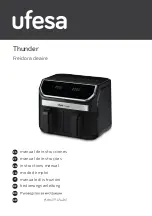
6
Advice: If the hose is long and the room
temperature low, the moisture might condense to
water inside the hose. This is an unavoidable
natural phenomenon. To prevent this water from
Iying in the hose or flowing back into the tumble
dryer, it is advisable to drill a small hole (dia.
3 mm) in the lowest point of the hose and to
place a small container below it.(See picture,
point A).
Once connected to the dryer, run the vent hose to
the desired outlet point, ensuring that the run’s
overall length is less than 2 m, and that it
contains no more than two bends. As to the outlet
itself, if you have decided on a fixed wall/window
grille, a good local builder’s merchant should be
able to supply you with the necessary fittings and
installation advice.
It is important not to connect the
vent hose to, for example, a cooker
hood, or a chimney or flue pipe
designed to carry the exhaust from
a fuel burning appliance.
Note that to avoid condensation problems, it is
essential that the dryer be fitted with the flexible
hose to carry its “exhaust” at least beyond the
kitchen units; preferable outside the kitchen.
In order to prevent the appliance from
overheating, it is important that the steam
exhaust is unobstructed.
Therefore, in case of a permanent hose fitted to
an exterior wall or ceiling, it must be ensured an
exhaust capacity of at least 150 m
3
/h.
If the dryer is fitted next to kitchen units,
make sure that the vent hose is not squashed.
If the hose is partially squashed, drying
efficiency will be reduced, resulting in longer
drying times and higher energy consumption.
If the hose is completely squashed, the safety
cut-outs with which the machine is fitted may
operate.
P0279
A
P0055
Summary of Contents for TDS 372T
Page 15: ...Z ...

































